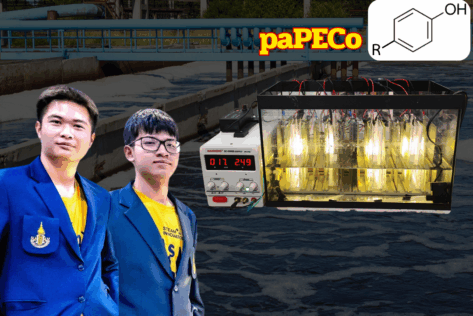heading

paPECo is an innovative system designed to treat phenolic compounds in industrial wastewater using photoelectrocatalysis. It works by catalyzing a semiconductor immobilized on an electrode with light and an electrical potential. The optimized FTO/WO₃/BiVO₄ electrode induces a continuous oxidation reaction, effectively decomposing phenolic compounds into carbon dioxide. This system offers rapid treatment within one hour, operates at a low energy consumption of 2.5 V, and reduces CO₂ emissions. In the context of fossil fuel-based electricity, paPECo promotes sustainable economic growth and while ensuring environmental responsibility, especially in water management. It aligns with SDG 6, 13, and 14, supporting global sustainability efforts.
This is how I came up with the idea for this project:Thailand frequently encounters issues related to water pollution, mainly caused by toxic substances from industrial wastewater. One significant concern is phenol, a highly toxic compound that is challenging to eliminate, commonly present in various industrial processes. We were inspired to apply our knowledge of chemistry, to address environmental challenges.
paPECo : Enhancing Phenolic Compound Removal Efficiency in Industrial Wastewater by Photoelectrocatalytic Using FTO/WO3/BiVO4 ElectrodesPhenolic compounds are commonly found in the wastewater of various industrial sectors and are highly toxic to aquatic ecosystems, even at low concentrations. In addition to their environmental impact, phenolic compounds pose risks to human health. Although they are not greenhouse gases themselves, their removal often requires energy-intensive treatment systems, indirectly contributing to greenhouse gas emissions and global warming. This research aims to develop paPECo, an innovative method for removing phenolic compounds from wastewater using a photoelectrocatalytic (PEC) electrode system. The study began with the development of semiconductor-based electrodes, followed by an evaluation of their efficiency in removing phenolic compounds from both synthetic and actual industrial wastewater. It also included a comparison of energy consumption and greenhouse gas emissions between paPECo and other phenol removal technologies. The results showed that electrodes fabricated by immobilizing WO3/BiVO4 semiconductors on FTO glass, with the BiVO4 layer annealed at 30°C, exhibited the highest photoelectrochemical properties. Using paPECo, phenolic compounds at concentrations of up to 5 ppm could be removed in less than one hour under PEC-enhanced conditions. Additionally, the system achieved a reduction of up to 90.2% in both energy consumption and greenhouse gas emissions compared to conventional high-energy systems such as aeration-based treatment. Thus, paPECo offers a novel and efficient solution for industrial wastewater management. It helps reduce treatment costs and significantly mitigates the environmental impact of greenhouse gas emissions, contributing to the sustainable resolution of climate change challenges in the industrial sector.

Documentation
paPECo : Enhancing Phenolic Compound Removal Efficiency in Industrial Wastewater by Photoelectrocatalytic Using FTO/WO3/BiVO4 Electrodes paPECo: An eco-friendly innovation that efficiently removes harmful phenolic compounds from wastewater, protecting health and aiding climate change mitigation with lower energy and cost.

